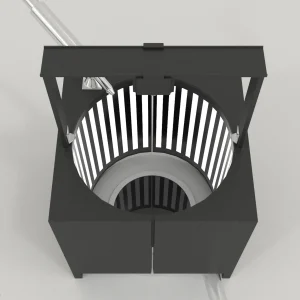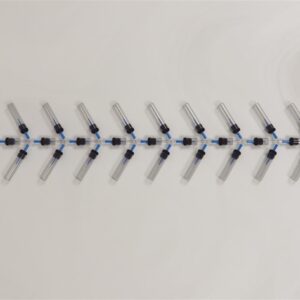$2,990.00
In a study conducted by Julien Foucaud and colleagues in 2010, the Heat Maze was utilized to evaluate spatial learning and cognition in Drosophila melanogaster. This device, designed to be straightforward, compact, and economical, is conceptually similar to the Morris water maze used for rodents but adapted specifically for insects and D. melanogaster.
The Heat Maze features a large circular arena situated atop a 565 array of Peltier elements that heat up to uncomfortable levels everywhere except in one designated “safe” zone.
During the experiment, it was observed that wild-type D. melanogaster flies could accurately find the safe zone using various visual cues. Notably, these flies were able to use information from distant visual cues to enhance their performance over multiple trials, thereby demonstrating spatial learning. The study also revealed that D. melanogaster progressively employed more spatially precise search strategies to locate the safe zone when consistent distal visual cues were available.
The Heat Maze is available from Mazeengineers.

MazeEngineers empowers preclinical neuroscience research with meticulously designed, customizable behavioral apparatuses. From manual classic mazes to fully automated smart systems, we provide the tools scientists need to capture high-quality, reproducible data for studies on learning, memory, anxiety, and depression.


bool(false)

Features |
Base Dimensions: 60 x 60 x 60cm |
Maze diameter: 18cm |
Talc-coated metal ring Height: 5cm |
Blank white paper sheet Height: 20 cm |
Floor: Peltier grid 5×5; diameter m 4x4cm – connected to electric power. |
Top: Sheet of paper (80g/m2) that serves as the floor surface. |
Temperature controller: Can be controlled manually or with the help of a computer |
**The arena wall or floor contains proximal and distant cues for spatial learning. |

The Heat Maze is an innovative behavioral paradigm designed to explore learning and memory in Drosophila melanogaster. Created by Julien, James, and Frederic in 2010, this maze leverages the principle that fruit flies can learn and remember visual locations.
Inspired by the Morris water maze (MWM), where subjects swim to a hidden platform using distant cues, the Heat Maze employs high temperature as a negative stimulus, encouraging subjects to escape the heat and find a safe area.
The setup includes a circular arena with both proximal and distal cues, which can be thermoregulated to motivate the subjects to locate a safe zone.
Researchers use the Heat Maze to examine the genetic, behavioral, and environmental influences on navigational strategies in Drosophila.
The Heat Maze features a circular acrylic arena with an 18 cm diameter.
The floor is composed of an array of Peltier elements arranged in a 5×5 grid with each element measuring 4×4 cm. These elements are powered and controlled via a control box, with temperature regulation managed through our Conduct Heat Maze software. During the experiment, the entire floor is heated to 37ºC, creating an unsafe zone, except for a safe zone measuring 4×4 cm where the temperature is kept at 20ºC.
*Please note that a talc-coated metal ring (height 5 cm) and a blank white paper sheet (height 20 cm) are not included.
Begin by thoroughly cleaning and configuring the apparatus as specified. Position a circular light bulb and a web camera (Noldus EthoVision® XT) above the setup. Maintain adult flies in groups of 20 or fewer at room temperature with a 12L:12D light-dark cycle. Ensure they have continuous access to food and water.
The subjects undergo training trials for spatial learning (7 trials, each lasting 5 minutes) and non-spatial learning (3 trials, each lasting 10 minutes), with a 10-second interval between trials.
This task examines Drosophila’s ability to find the safe zone in the maze using proximal and distal cues. For proximal cues, place a green dot on the floor in the center of the safe zone and a red dot in the unsafe zone, keeping the maze walls blank. For distal cues, decorate the walls of the maze with four different patterns (vertical and horizontal stripes, diamonds, and a 16-branched star), indicating safe zones with the star and diamond patterns. Heat the entire circular arena except for the safe zone, then place the subject in the apparatus. Allow the subject to fly within the arena to locate the safe zone to escape the heat, and record the time taken to reach and stay in the safe zone.
Partition the flies into control, test, and random groups, granting each individual access to the maze independently. Employ a plain floor and wall configuration, with designated patterns serving as the safe zone.
For the ‘control’ group, maintain the position of the wall pattern indicating the safe zone constant throughout the trials. In the ‘test’ group, rotate the position by 180º in the final trial. For the ‘random’ group, randomly rotate the arena wall so that the wall patterns remain unpredictable and unreliable as spatial cues. Record the time taken to locate the safe zone for each group.
Behavioral and neurobiological phenomena have long been a focal point of study in model organisms, spanning mammals (including rodents, primates, and humans) and insects (such as bees and ants). Despite Drosophila being heralded as a model species for learning and neurobiological investigations (Pitman et al., 2009; Vosshall & Stocker, 2007), research into spatial learning in this species has been limited. Understanding these processes is essential for unraveling the genetic, neuroanatomical, and eco-evolutionary factors that shape learning abilities across different species, shedding light on the strategies animals employ to navigate their environment.
Julien and colleagues (2010) devised the Heat Maze as a tool to explore hippocampal-related abilities and the neural circuits underlying them in flies. Vision serves as a primary means for flies to gather information about their surroundings, including critical features like color, size, and shape.
In their study, researchers subjected healthy adult flies to examine the extent to which vision contributes to the development, retention, and recall of specific locations. Flies were immobilized on ice, and their wings clipped 12-24 hours prior to experimentation. Through training, the flies demonstrated the ability to identify the safe target within the challenging environment of the maze. This led the experimenters to conclude that fruit flies possess visual place memory and exhibit spatial navigation skills. In their natural habitat, they likely rely on visual landmarks to find their way to the nest or other safe locations.
In a comparable study, Tyler, Charles, and Michael (2011) conducted an experiment involving 15 flies placed within a thermal-visual arena enclosed by a glass disc. Within the initial 5 minutes, nearly all flies (94%) successfully located the ‘cool target.’ Subsequent trials involved rotating both the target and its associated visual cues either 90º clockwise or anti-clockwise. Analysis of the data from the ensuing 10 trials revealed a marked enhancement in location identification. The flies demonstrated a notable improvement in their ability to swiftly locate and approach the target, opting for shorter, more direct routes.
In a study by Jan, Michael, and Barbara (2008), female crickets (Gryllus bimaculatus) were introduced into a heated setup known as the Tennessee Williams paradigm. This apparatus featured a metal floor positioned above a water tank, with the base of the metal floor heated to 50ºC, subsequently warming the entire surface. Within this setup, a visually undetectable cool spot was integrated into the floor.
Upon being introduced into the arena, the heat stimulus prompted the subject to quickly search for the cool spot. Over approximately 10 trials, significant progress was observed in the subject’s ability to locate and access the target spot rapidly.
In a study conducted by Garbriel and Martin (2002), learning and memory dynamics were investigated using a similar apparatus known as the Heat Box. This box comprised an array of 15 chambers equipped with Peltier elements positioned both on top and bottom. Each chamber was divided into two equal sections: one designated as “punished” and the other as “unpunished.”
During the pre-test phase, Drosophila were permitted to explore the box, which was maintained at a temperature of 20ºC, for a duration of 20 seconds. Subsequently, in the training phase, the temperature escalated to 40ºC whenever a fly entered the punished side. In the testing phase, a performance index was computed to assess the disparity in time spent between the punished and unpunished zones, respectively.
The Heat Maze is similar to the Morris Water Maze (MWM). In the Heat Maze, a Peltier element marks the safe zone, akin to the hidden platform in the MWM, where the subject swims to find refuge. In the MWM, the subject must swim swiftly to a platform to avoid drowning, while in the Heat Maze, heat stress drives D. melanogaster to fly towards a safe zone.
In the Heat Maze, the cues are consistently visual, whereas in the MWM, they can be olfactory, visual, or auditory. Despite this difference, the purpose of the cues in both mazes is identical: to help orient and guide the subject to safety.
The MWM is a widely used and highly successful rodent paradigm with numerous applications.
Subjects display seven distinct search strategies while learning to navigate to the safe zone:
Additionally, the following performance parameters are monitored in both non-spatial and spatial trials:
The Heat Maze is an easy-to-assemble task with a straightforward design requiring minimal handling.
It can effectively evaluate and differentiate between spatial and non-spatial learning in flies. By varying the protocol with different visual cues, control groups, and random groupings, it provides a comprehensive view of Drosophila’s ability to utilize both egocentric and allocentric strategies to navigate to a safe zone. The task consistently yields reliable and accurate results in both configurations.
The heat in the task acts as a negative reinforcer, allowing for the analysis of flies’ ability to avoid adverse conditions. The maze’s temperature can be manually or computer-controlled to prevent overheating or underheating, as temperature fluctuations can affect performance and outcomes. The task is conducted at a non-lethal temperature.
The use of heat can induce stress in the flies. Despite the short duration of thermal exposure and the time taken to locate and reach the safe zone, the task places fruit flies in a stressful situation. Thermal stress depletes their energy by affecting metabolism and physiological functions. Peter, Martina, Yanjun, and Ronald (2016) found that temporary thermal stress or permanently elevated temperatures lead to fat depletion in the body. Combining thermal stress with food deprivation results in reduced life expectancy in the flies.
Heat stress can also negatively impact the fecundity of flies and increase the likelihood of premature and permanent sterility.
The Heat Maze highlights gender differences in navigation between male and female flies. Female flies are generally less active in locating the zone compared to males. More modifications in the design are needed to accurately evaluate gender-based spatial learning in insects.
Burns, J.G., Foucaud, J., & Mery, F. (2010). Use of spatial information and search strategies in a water maze analog in Drosophila melanogaster. PLoS One, 5(12), e15231. http://dx.doi.org/10.1371/journal.pone.0015231
DasGupta, S., Krashes, M.J., Leung, B., Perrat, P.N., Pitman, J.L., & Waddell, S. (2009). There are many ways to train a fly. Fly (Austin), 3(1), 3-9.
Stocker R.F., & Vosshall, L.B. (2007). Molecular architecture of smell and taste in Drosophila. Annu Rev Neurosci, 30, 505-33. http://dx.doi.org/10.1146/annurev.neuro.30.051606.094306
Ofstad, T.A., Reiser, M.B., & Zuker, C.S. (2011). Visual Place Learning in Drosophila melanogaster. Nature, 474(7350), 204–207. http://dx.doi.org/10.1038/nature10131
Mangan, M., Webb, B., & Wessnitzer, J. & (2008). Place memory in crickets. Proc Biol Sci, 275(1637), 915-21. http://dx.doi.org/10.1098/rspb.2007.1647
Heisenberg M., & Putz G. (2002). Memories in drosophila heat-box learning. Learn Mem, 5,349-59. http://dx.doi.org/10.1101/lm.50402
Gáliková, M., Klepsatel, P., Kühnlein, R.P., Xu, Y. & (2016). Thermal stress depletes energy reserves in Drosophila. Sci Rep, 33667. http://dx.doi.org/10.1038/srep33667
There are no questions yet. Be the first to ask a question about this product.